Other names Cú/ Cú Faoil ANKC Group 4 (Hound) CKC Group 2 (Hound) Scientific name Canis lupus familiaris | AKC Hound Group 4 (Hound) standard Hypoallergenic No Life span 6 – 10 years | |
 | ||
FCI Group 10, Section 2 Rough-haired Sighthounds #160 Temperament Loyal, Sweet-Tempered, Generous, Dignified, Thoughtful, Patient Colors Black, White, Red, Grey, Fawn, Brindle Similar | ||
Dog breeds irish wolfhound dogs 101 animal planet
The Irish Wolfhound (Irish: Cú Faoil, [ˈkuː ˈfˠiːlʲ]) is a breed of domestic dog (Canis lupus familiaris), specifically a very large sighthound from Ireland. The name originates from its purpose—wolf hunting with dogs—rather than from its appearance. Originally developed from war hounds to one used for hunting and guarding, Irish Wolfhounds can be an imposing sight due to their formidable size.
Contents
- Dog breeds irish wolfhound dogs 101 animal planet
- Akc dog breed series irish wolfhound
- History
- Pre 19th century
- Modern wolfhound
- Appearance
- Temperament
- Health
- References
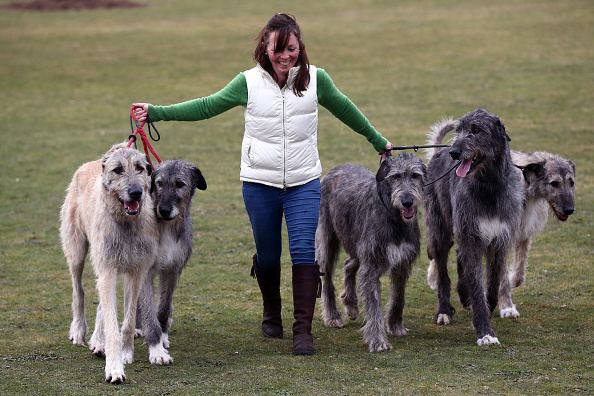
Akc dog breed series irish wolfhound
History
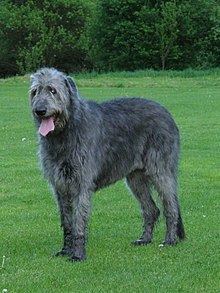
The breed is very old; there are suggestions it may have been brought to Ireland as early as 7000 BC. These dogs are mentioned, as cú (variously translated as hound, Irish hound, war dog, wolf dog, etc.) in Irish laws and in Irish literature which dates from the 5th century or, in the case of the Sagas, from the old Irish period - AD 600-900. The word "Cu" often became an added respected prefix on the names of warriors as well as kings denoting that they were worthy of the respect and loyalty of a Cu.
Pre-19th century

Ancient woodcuts and writings have placed them in existence as a breed by 273 BC. However, there is indication that huge dogs existed even as early as 279 BC when the Tectosages and Tolistobogii Celts sacked Delphi. Survivors left accounts of the fierce Celts and the huge dogs who fought with them and at their side. They were mentioned by Julius Caesar in his treatise, The Gallic Wars, and by 391 AD, they were written about by Roman Consul, Quintus Aurelius Symmachus, who received seven of them, "canes Scotici", as a gift to be used for fighting lions and bears, in his words, "all Rome viewed (them) with wonder".
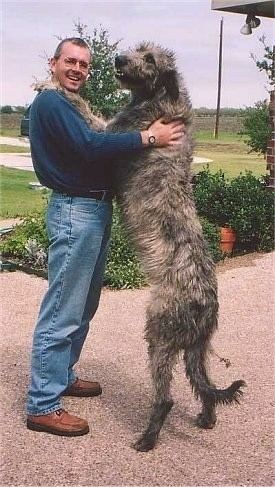
Wolfhounds were bred as hunting dogs by the ancients, who called them Cú Faoil. The Irish continued to breed them for this purpose, as well as to guard their homes and protect their stock. Cúchulain, a name which translates literally as "hound of Culain", gained his name when as a child, known then as Setanta, he slew the ferocious guard dog of Culain forcing him to offer himself as a replacement.
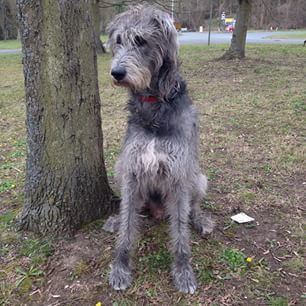
During the English Conquest of Ireland, only the nobility were allowed to own Irish Wolfhounds, the numbers permitted depending on position. They were much coveted and were frequently given as gifts to important personages and foreign nobles. Wolfhounds were the companions of the regal, and were housed themselves alongside them. King John of England, in about 1210 presented an Irish hound, Gelert to Llewellyn, a prince of Wales. The poet The Hon William Robert Spencer immortalised this hound in a poem.
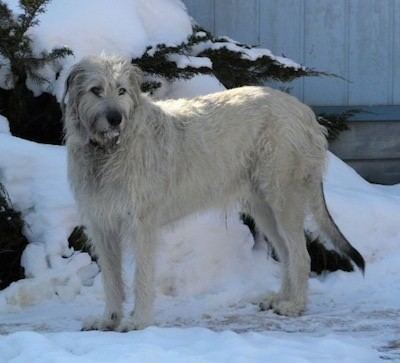
In his Historie of Ireland completed 1571, Edmund Campion gives a description of the hounds used for hunting the wolves on the Dublin and Wicklow mountains. He says: They (the Irish) are not without wolves and greyhounds to hunt them, bigger of bone and limb than a colt. Due to their popularity overseas many were exported to European royal houses leaving numbers in Ireland depleted. This led to a declaration by Oliver Cromwell himself being published in Kilkenny on 27 April 1652 to ensure that sufficient numbers remained to control the wolf population.
References to the Irish wolfhound in the 18th century tell of its great size, strength and greyhound shape as well as its scarcity. Writing in 1790, Bewick described it as the largest and most beautiful of the dog kind; about 36 inches high, generally of a white or cinnamon colour, somewhat like the Greyhound but more robust. He said that their aspect was mild, disposition peaceful, and strength so great that in combat the Mastiff or Bulldog was far from being an equal to them. The last wolf in Ireland is thought to have been killed at Myshall, Co Carlow in 1786 by a pack of wolfdogs kept by a Mr Watson of Ballydarton. The remaining hounds in the hands of a few families who were mainly descendants of the old Irish chieftains, were now symbols of status rather than hunters, they were said to be the last of their race.
Modern wolfhound
Scotsman Captain George Augustus Graham is responsible with a few other breeders for attempting to reaffirm the breed's existence. In 1879 he wrote: "It has been ascertained beyond all question that there are few specimens of the breed still left in Ireland and England to be considered Irish wolfhounds, though falling short of the requisite dimensions. This blood is now in my possession." Captain Graham devoted his life to ensuring the survival of the Irish wolfhound. Owing to the small numbers of surviving specimens outcrossing was used in the breeding programme. It is believed that Borzoi, Great Dane, Scottish Deerhound and English Mastiff dogs all played their part in Graham's creation of the dog we currently know. The famous English Mastiff Garnier's Lion was bred to the Deerhound Lufra, and their offspring Marquis enters Wolfhound pedigrees through his granddaughter Young Donagh. Graham included "a single outcross of Tibetan Wolf Dog". This was long assumed to have been a Tibetan Mastiff. However, a photograph of "Wolf" shows a bearded, long-coated dog—what would now be called a "Tibetan Kyi Apso" or "dokhyi apso". In 1885 Captain Graham with other breeders founded the Irish Wolfhound Club, and the Breed Standard of Points to establish and agree the ideal to which breeders should aspire.
The Wolfhound was historically a dog that only nobles could own and was taken up by the British during their rule in Ireland. This made it unpopular as a national symbol and the Kerry Blue Terrier was adopted by Republicans such as Michael Collins.The Wolfhound has been adopted as a symbol by both rugby codes. The national rugby league team are nicknamed the wolfhounds, and the Irish Rugby Football Union, which governs rugby union, changed the name of the country's A (second-level) national team in that code to the Ireland Wolfhounds in 2010.
Appearance
Considered by the American Kennel Club to be the tallest of all dog breeds, describing the breed as, "Of great size and commanding appearance, the Irish Wolfhound is remarkable in combining power and swiftness with keen sight. The largest and tallest of the galloping hounds, in general type he is a rough-coated, Greyhound-like breed; very muscular, strong though gracefully built; movements easy and active; head and neck carried high, the tail carried with an upward sweep with a slight curve towards the extremity". The average height of an Irish wolfhound should be taller than that of a Great Dane. However, the wolfhound is not to be confused with being the heaviest, as its structure should be similar to that of a Greyhound, with a very broad and deep chest that tucks up.
Its colour may be grey, brindle, red, black, white, fawn, and wheaten.
The Irish wolfhound was bred for long solitary hunts based solely on the dog's ability to visualize its landscape and perceive, unlike scent hounds (such as Bloodhounds and Beagles) who rely on scent rather than sight. For this reason, the neck of an Irish wolfhound should be long with the head held high the majority of the time. The Irish wolfhound should also appear to be longer than it is tall. Once used to hunt wolves, an Irish wolfhound’s structure should appear as if it is “fast enough to catch a wolf, and strong enough to kill it”.
The AKC specifies the minimum height as 32 inches (0.81 m) for mature males, 30 inches (0.76 m) for females; the minimum weight: 120 pounds (54 kg) for males, 105 pounds (48 kg) for females. It is not rare to see modern day female hounds reaching the minimal height requirements of those of male hounds; most females are well over 30 inches (0.76 m) and in most AKC conformation shows a wolfhound’s height is looked at with as much importance as the hound’s head and face structure. Per the AKC, great size, including height of shoulder and proportionate length of body is to be aimed at, to firmly establish a breed averaging 32–34 inches (0.81–0.86 m) in males. The height/weight standards in Ireland and England are slightly different.
Temperament
Irish wolfhounds have a varied range of personalities and are most often noted for their personal quirks and individualism. An Irish wolfhound, however, is rarely mindless, and despite its large size is rarely found to be destructive in the house or boisterous. This is because the breed is generally introverted, intelligent, and reserved in character. An easygoing animal, the Irish Wolfhound is quiet by nature. Wolfhounds often create a strong bond with their family and can become quite destructive or morose if left alone for long periods of time. An Irish wolfhound is not a guard dog and will protect individuals rather than the house or the owner’s possessions. However independent the wolfhound is, the breed becomes attached to both owners and other dogs they are raised with and is therefore not the most adaptable of breeds. Bred for independence, an Irish wolfhound is not necessarily keen on defending spaces. A wolfhound is most easily described by its historical motto, “gentle when stroked, fierce when provoked”. Despite the need for their own people, Wolfhounds generally are somewhat stand-offish with total strangers. They should not be territorially aggressive to other domestic dogs but are born with specialized skills and it is common for hounds at play to course another dog. This is a specific hunting behavior, not a fighting or territorial domination behavior. Most Wolfhounds are very gentle with children. The Irish Wolfhound is relatively easy to train. They respond well to firm, but gentle, consistent leadership. However, historically these dogs were required to work at great distances from their masters and think independently when hunting rather than waiting for detailed commands and this can still be seen in the breed.
The Wolfhound of today is far from the one that struck fear into the hearts of the Ancient Romans. Irish Wolfhounds are often favored for their loyalty, affection, patience and devotion. Although at some points in history they have been used as watchdogs, unlike some breeds, the Irish Wolfhound is usually unreliable in this role as they are often friendly toward strangers, although their size can be a natural deterrent. However, when protection is required this dog is never found wanting. When they or their family are in any perceived danger they display a fearless nature. Author and Irish Wolfhound breeder Linda Glover believes the dogs' close affinity with humans makes them acutely aware and sensitive to ill will or malicious intentions leading to their excelling as a guardian rather than guard dog.
Health
Like many large dog breeds, Irish Wolfhounds have a relatively short lifespan. Published lifespan estimations vary between 6 and 10 years with 7 years being the average. Dilated cardiomyopathy and bone cancer are the leading cause of death and like all deep-chested dogs, gastric torsion (bloat) is common; the breed is affected by hereditary intrahepatic portosystemic shunt.
In a privately funded study conducted under the auspices of the Irish Wolfhound Club of America and based on an owner survey, Irish Wolfhounds in the United States from 1966 to 1986 lived to a mean age of 6.47 and died most frequently of bone cancer. A more recent study by the UK Kennel Club puts the average age of death at 7 years.
Studies have shown that neutering is associated with a higher risk of bone cancer in various breeds, with one study suggesting that castration of male Irish Wolfhounds should be avoided at least until the dog is fully grown.
Irish wolfhounds should not receive additional supplements when a good dog food is used. It is generally accepted that they should be fed a low protein adult dog food (19 to 21% protein) from puppyhood onward. Most breeders today recommend that they not be supplemented to slow their rapid growth.
Irish wolfhounds are the tallest of all dog breeds, sometimes reaching 7 feet tall on their hind legs. They are well suited to rural life, but their medium energy profile allows them to adjust fairly well to suburban and urban life as well, provided they receive appropriate exercise.
Genetically, the Irish wolfhound as a breed is threatened by a bottleneck related to the over-use of a popular sire.
